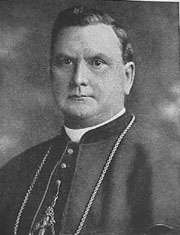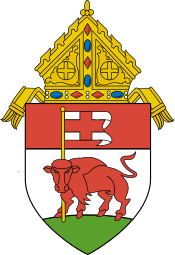James Edward Quigley
| The Right Reverend James E. Quigley | |
|---|---|
| Archbishop of Chicago | |
 | |
| Church | Roman Catholic Church |
| See | Chicago |
| In office | January 8, 1903 – July 10, 1915 |
| Predecessor | Patrick Feehan |
| Successor | George Cardinal Mundelein |
| Orders | |
| Ordination | April 13, 1879 |
| Consecration | February 24, 1897 |
| Personal details | |
| Born |
October 15, 1854 Oshawa, Ontario, Canada |
| Died |
July 10, 1915 (aged 60) Chicago, Illinois |
| Previous post | Bishop of Buffalo |
James Edward Quigley (October 15, 1854 – July 10, 1915) was a Canadian-born prelate of the Roman Catholic Church. He served as Bishop of Buffalo, New York (1897–1903) and Archbishop of Chicago (1903–1915).
Biography
Early life and education
James Quigley was born in Oshawa, Ontario, and came to the United States with his parents at age 2, settling at Lima, New York near Rochester.[1] At the age of ten he was sent to live with his uncle, Father Edward Quigley, the rector of Immaculate Conception Church in downtown Buffalo. After graduating from St. Joseph's College in 1872, he won a competitive examination for entrance into the United States Military Academy, but soon relinquished his military ambition to study for the priesthood. He then entered Our Lady of Angels Seminary at Niagara Falls, New York, and later furthered his studies at the University of Innsbruck in Austria and College of Propaganda in Rome.[2]
Ordination and ministry
While in Rome, Quigley was ordained a priest on April 13, 1879.[3] Following his return to the United States, he served as pastor of St. Vincent's Church in Attica, New York until 1884, when he became rector of St. Joseph's Cathedral in Buffalo.[1] He was transferred to St. Bridget's Church in the same city in 1886.[2]
Bishop of Buffalo
On December 12, 1896 he was appointed Bishop of Buffalo, where he was consecrated bishop on February 24, 1897 by Archbishop Michael Corrigan of New York. Nearly all the faculty and many of the students at Our Lady of the Angels Seminary went to Buffalo to observe the ceremonies.[4]
In keeping with Pope Leo XIII's 1891 encyclopedia Rerum novarum, Quigley took an active interest in working conditions. During the dock strike of Buffalo in 1899 the Lake Carriers' Association and the Longshoremen's Union chose him as mediator. After ten days of negotiations, the strike was settled on terms reached by the bishop. It was routine to pay workers in saloons, where often the saloonkeeper was also the hiring boss. This practice was terminated and prohibited by the terms of the agreement.[5]
In 1902 socialists had begun to influence the unions in Buffalo to the extent that in some instances regulations were adopted that the Catholic members found unjust and oppressive. At the request of a number of German priests, Bishop Quigley wrote a pastoral letter in German to be read in their congregations calling on Catholic union members to assert their rights regarding union governance. Mass meetings were held, at which Quigley spoke. He asserted the Church's support of labor unions, denounced socialism and explained why the Church opposed the principles of socialism. The result was that the socialists lost control of the labor unions,[5] and Quigley gained a national reputation.[6]
Archbishop of Chicago
Bishop Quigley was appointed Archbishop of Chicago, on January 8, 1903 and installed March 10, 1903. He served as archbishop until his death at the age of 60.
Archbishop Quigley Preparatory Seminary in Chicago is named in his honor.
References
- 1 2 Waterman, Arba Nelson (1908). Historical Review of Chicago and Cook County. The Lewis Publishing Company.
- 1 2 "Archdiocese of Chicago". Catholic Encyclopedia.
- ↑ "Archbishop James Edward Quigley". Catholic-Hierarchy.org.
- ↑ "Rt. Rev. James Edward Quigley, D.D.", History of the Seminary of Our Lady of Angels, The Matthews-Northrup Works, Buffalo, 1906
- 1 2 Czarnecki, Anthony. "The Most Reverend James Edward Quigley", Hearst's International, Vol.4, International Publications, Incorporated, 1903
- ↑ Donohue, Thomas. "Buffalo." The Catholic Encyclopedia Vol. 3. New York: Robert Appleton Company, 1908. 4 Oct. 2015
| Catholic Church titles | ||
|---|---|---|
| Preceded by Patrick Augustine Feehan |
Archbishop of Chicago 1903 - 1915 |
Succeeded by George Mundelein |
| Preceded by Stephen V. Ryan |
Bishop of Buffalo 1897 – 1903 |
Succeeded by Charles H. Colton |

